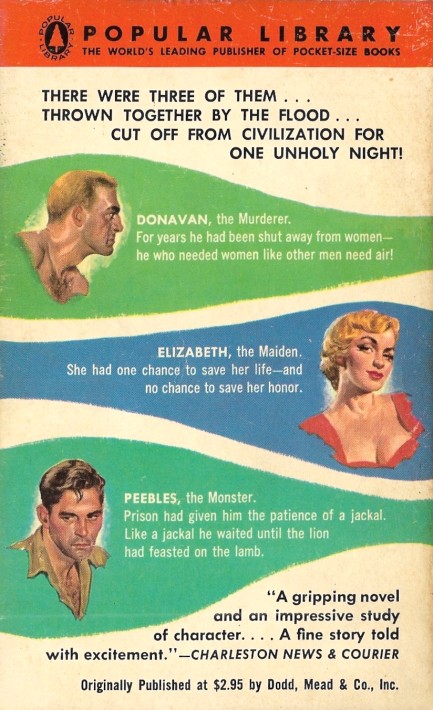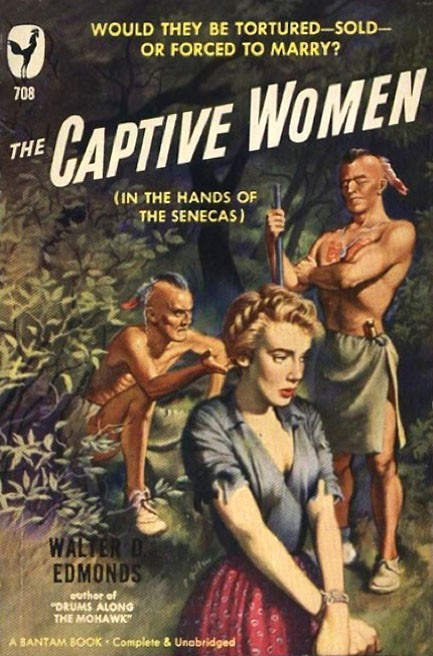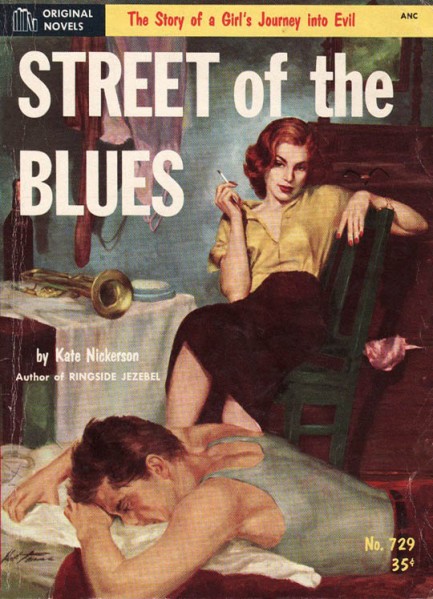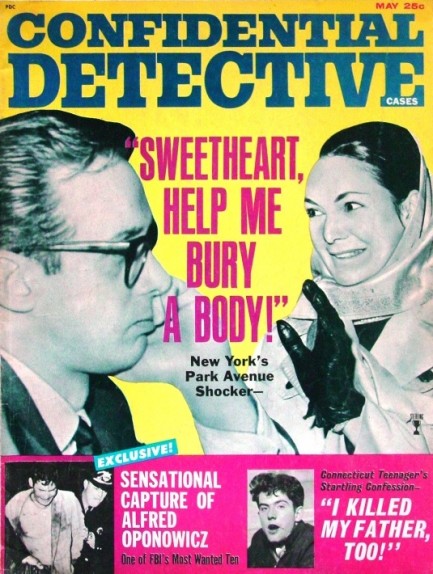 When nature goes mad human nature follows suit.  
As you probably know, we have an attraction to books set in tropical lands. We also, to a similar extent, are automatically drawn to books set during natural disasters. Examples include John D. MacDonald's Murder in the Wind, Frederik Pohl and C.M. Kornbluth's A Town Is Drowning, Louis A. Brennan's Death at Flood Tide, Theodore Pratt's Tropical Disturbance, Rain of Terror by Malcolm Douglas, and The Angry Mountain by Hammond Innes. John and Ward Hawkins' A Girl, a River, and Man is an addition to the collection. The book appeared in the above Popular Library edition in 1957, but had been originally published a year earlier as The Floods of Fear, and appeared even earlier in serial form in The Saturday Evening Post.
These two authors certainly know what they're about. A Girl, a River, and Man is propulsive, action packed, well characterized, and climaxes violently. The premise is that, during a major flood, a group of convicts pressed into service to reinforce a dike are caught by rising waters and swept away. Two convicts survive, along with a prison guard, and into the mix is thrown a woman unluckily stranded in the same area. The interaction between this group is volatile, to say the least. One convict, who's a career armed robber, wants simply to loot. The other, a murderer, wants to kill the person most responsible for sending him to jail. The prison guard, meanwhile, is obsessive about putting both jailbirds back into the joint—no matter the cost.
There's no mystery about the fact that the murderer may not have committed the crime. Though prison has hardened him to the extent that he's a terrifying presence, his possible innocence becomes obvious early on, and it's the element that catalyzes the actions and reactions that energize the tale. As a magazine serial compiled into novel form, A Girl, a River, and Man is both short and filled with mini-climaxes that drive the reader inexorably toward the finale. There's more action packed into the story than any five typical 1950s-era novels. The Hawkins brothers falter slightly when dealing with the inevitable romantic subplot, but otherwise this is pure escapist adventure executed at a high level, and we recommend it strongly.
 This woman is useless, brother. She can’t even gut a fish. What are we to do with her? And stop saying “schwing” when I ask that. I have no idea what that means. 
Above, a cover for Walter D. Edmonds’ frontier novel The Captive Women, which appeared in 1950 as a paperback, 1949 as a hardback, and had been serialized in 1937 in the Saturday Evening Post as In the Hands of the Senecas. Basically, what you get here are separate accounts of whites, mostly women, who have been captured by Native Americans, circa 1776 to 1784. Edmonds, who wrote the acclaimed Drums Along the Mohawk, specialized in historical novels set in the American northeast. The right of white men to invade the land is presumed, but you still have to consider this fairly balanced writing for the time period. The Indians have personalities and motivations, which is the most you can hope for in 1930s-era pop fiction on this particular subject. The captive whose odyssey is followed most closely is that of a newlywed named Delia, who ends up wife to an Indian chief and bears him a child. Edmonds also wrote about fifteen books for children, including Bert Breen’s Barn, which won the National Book Award for Children’s Literature in 1976. The art here is by Denver Gillen, whose work you can see much more of at this blog.
 Um, anytime you’re finished with the pity party… 
This fun cover of Kate Nickerson’s 1952 novel Street of the Blues, is by Herb Tauss, who wasn’t just a painter, but also a sculptor, and was inducted into the Illustrator’s Hall of Fame. He was self-taught, but even without a pedigree earned assignments with magazines as diverse as National Geographic, Good Housekeeping and The Saturday Evening Post. Later in his career he moved into fine art and did some teaching. His work is hard to find, but we'll keep an eye out for more.

 Forty-three years ago this month Richard Speck shocked America.  This July 1, 1967 cover of The Saturday Evening Post shows mass murderer Richard Speck, who, a little less than a year earlier on July 13, 1966, broke into a Chicago townhouse where he raped and killed eight student nurses in a single horrific night. The crime stunned America, and questions about how any man could be so monstrous soon focused on Speck’s brain. At the time of this cover, some genetic researchers thought he was an abnormal 47,XYY karyotype, which was thought to cause hyper-aggression. But Speck was ruled competent to stand trial, was convicted of the murders and sentenced to death, then to life in prison when the U.S. Supreme Court cited irregularities in jury selection during his trial. This July 1, 1967 cover of The Saturday Evening Post shows mass murderer Richard Speck, who, a little less than a year earlier on July 13, 1966, broke into a Chicago townhouse where he raped and killed eight student nurses in a single horrific night. The crime stunned America, and questions about how any man could be so monstrous soon focused on Speck’s brain. At the time of this cover, some genetic researchers thought he was an abnormal 47,XYY karyotype, which was thought to cause hyper-aggression. But Speck was ruled competent to stand trial, was convicted of the murders and sentenced to death, then to life in prison when the U.S. Supreme Court cited irregularities in jury selection during his trial. Thirty years later, in 1996, Richard Speck burst into public consciousness again when an investigation into Illinois prison conditions uncovered a 1988 video of Stateville Prison inmates—most notably Speck—consuming drugs and alcohol with no fear of being caught. Speck also was shown in a pair of silk panties, performed oral sex on another prisoner, and had grown what appeared to be breasts, reportedly from consuming contraband hormones. Stateville had become a giant, orgiastic party. At one point Speck said, “If they only knew how much fun I was having, they’d turn me loose.” By now doctors had proven Speck didn't possess an extra Y chromosome, so most experts focused on his childhood as a cause of his murderous rampage. His youth had been marked by abandonment, abuse, and at least three serious blows to the head. When he finally died of a heart attack—in 1991, five years before the infamous Stateville videotape surfaced—an autopsy revealed that his brain was abnormal after all. His hippocampus and amygdala—the latter of which helps regulate rage and emotional reactions—had fused. Speck was cremated and his ashes were scattered by a newspaper columnist, a fieldhand, and two country employees, who all agreed to keep the location secret forever. Stateville videotape surfaced—an autopsy revealed that his brain was abnormal after all. His hippocampus and amygdala—the latter of which helps regulate rage and emotional reactions—had fused. Speck was cremated and his ashes were scattered by a newspaper columnist, a fieldhand, and two country employees, who all agreed to keep the location secret forever.
 Cuban firebrand graces the cover of one of America’s oldest magazines. 
This Saturday Evening Post cover, with an article about worsening conditions inside Cuba, features one of the most dynamic Fidel Castro images from the 1960s. The story qualifies as propaganda, because it fails to mention the U.S. embargo as a cause of the problems, instead blaming them on corruption, administrative incompetence, and, ultimately, an inferior political system destined for collapse. The collapse never happened, and Castro remains a polarizing figure on the world political scene. He has appeared on thousands of magazine covers, both respectable and trashy. This issue of the venerable Saturday Evening Post first hit newsstands today, forty-six years ago.
 With this ring, I thee dread. 
Today’s eye-catching cover from Confidential Detective Cases, May 1965, features a story about a Park Avenue couple and their failed attempt to disappear a body. If it was the wife asking for help, we aren’t surprised the scheme went awry—most men won’t help with the dishes, let alone a cadaver. However, it’s possible the husband was the one asking for help. If so, this story might be referring to the Mark Fein case. It seems to fit—Fein was a jet-setter with a palatial apartment on Park Avenue. In 1965 he killed his bookie, stuffed him in a trunk and, with the help of his wife and two others, dumped him in the East River. The trunk bobbed to the surface days later and soon the cops came knocking on Fein’s door. According to a Saturday Evening Post article, Fein’s wife said to him in disgust, “Didn’t you ever hear of cement?” As punch lines to one’s own arrest rate, it doesn’t quite approach, “And it would have worked, too, if it wasn’t for you pesky kids!” but it’s pretty close. We’ll have more Confidential Detective Cases covers down the line.
|
 |

The headlines that mattered yesteryear.
2003—Hope Dies
Film legend Bob Hope dies of pneumonia two months after celebrating his 100th birthday. 1945—Churchill Given the Sack
In spite of admiring Winston Churchill as a great wartime leader, Britons elect
Clement Attlee the nation's new prime minister in a sweeping victory for the Labour Party over the Conservatives. 1952—Evita Peron Dies
Eva Duarte de Peron, aka Evita, wife of the president of the Argentine Republic, dies from cancer at age 33. Evita had brought the working classes into a position of political power never witnessed before, but was hated by the nation's powerful military class. She is lain to rest in Milan, Italy in a secret grave under a nun's name, but is eventually returned to Argentina for reburial beside her husband in 1974. 1943—Mussolini Calls It Quits
Italian dictator Benito Mussolini steps down as head of the armed forces and the government. It soon becomes clear that Il Duce did not relinquish power voluntarily, but was forced to resign after former Fascist colleagues turned against him. He is later installed by Germany as leader of the Italian Social Republic in the north of the country, but is killed by partisans in 1945.
|

|
|

It's easy. We have an uploader that makes it a snap. Use it to submit your art, text, header, and subhead. Your post can be funny, serious, or anything in between, as long as it's vintage pulp. You'll get a byline and experience the fleeting pride of free authorship. We'll edit your post for typos, but the rest is up to you. Click here to give us your best shot.

|
|










 Stateville videotape surfaced—an autopsy revealed that his brain was abnormal after all. His hippocampus and amygdala—the latter of which helps regulate rage and emotional reactions—had fused. Speck was cremated and his ashes were scattered by a newspaper columnist, a fieldhand, and two country employees, who all agreed to keep the location secret forever.
Stateville videotape surfaced—an autopsy revealed that his brain was abnormal after all. His hippocampus and amygdala—the latter of which helps regulate rage and emotional reactions—had fused. Speck was cremated and his ashes were scattered by a newspaper columnist, a fieldhand, and two country employees, who all agreed to keep the location secret forever.







































































